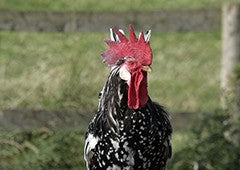If you're thinking of keeping chickens in your area, it’s important to check the council regulations in your area before you set up your coop and purchase your flock. Every council will definitely allow you to keep chickens, and generally the rules are quite common-sense - pertaining to how many you can keep, coop requirements and chicken maintenance.
Here are the council laws in the capital city of each Australian state, as well as the main guidelines they provide. Remember, if you live in areas other than the ones listed, make sure you check your local councils website as the rules may vary.
1. Queensland
Summary: Residential houses can keep six fowl of most kinds (peafowl, geese, ducks etc.), no stringent requirements for coop dimensions or size given.
(This example is from the Brisbane City Council)
Rural
If your residence has a total area of 900m2 or more, then you can have a maximum of 20 chickens without a permit. If you want more, you will have to apply for council permission.
Residential
If the total area of your residence is less than 800m2, then you can keep a maximum of 6 chickens.
Other guidelines:
-
NO roosters on residential properties
-
Coops must be 1m from any dividing fences in the backyard
-
Clear up the chickens waste from the backyard
-
Take precautions to keep pests at bay i.e. storing food in tight containers
Council website: http://www.brisbane.qld.gov.au/laws-permits/laws-permits-residents/animals-pets/chickens-poultry
2. New South Wales
Summary: 10 chickens maximum in residential areas. Maximum coop height and area requirements are specified and must be met. There must be measures in place to keep odours/rodents at bay.
(This example is from the North Sydney Council)
Residential
No more than 10 chickens allowed in residential areas.
Other guidelines:
-
NO roosters in residential areas
-
Coop size - floor area no more than 15m2, maximum height 3m
-
The coop must be located in a rear yard
-
One coop per property
-
“Constructed with a floor of concrete or mineral asphalt underneath roosts or perches” - therefore coop must be placed on concrete or asphalt block.
-
Poultry must not be able to escape from yard
-
The backyard must be kept clean/free from odours
Council website: https://www.northsydney.nsw.gov.au/Waste_Environment/Sustainability/At_Home/Keeping_Chickens
3. Victoria
Summary: You can keep up to 5 chickens in residential areas - as long as you have adequate backyard space, can give them constant access to nourishment and they don’t disrupt the neighbourhood.
(Rules and guidelines are taken from the City of Yarra council as an example)
Residential
Residences with backyards can have a maximum of five chickens. People residing in flats or units are not permitted to keep chickens.
Other guidelines:
-
The chicken coop should not be “housed within the front setbank to the street or the side setback to a side street.”
-
The chicken coop must be placed at least two metres away from the neighbouring properties’ fence.
-
Chickens must not interfere or disrupt the peace of the neighbourhood.
-
Owners must provide sufficient food and water, and enough space for them to roam around the enclosure.
Council website: https://www.yarracity.vic.gov.au/services/pets-and-animals/other-animals-and-pests
4. South Australia
Summary: Maximum of 4 chickens in residential areas. Strict guidelines on spacing requirements, coop materials and odour/rodent prevention.
(This example is from Adelaide Hills Council).
Residential
If you are keeping chickens, we recommend no roosters due to noise problems.
Other guidelines
-
The chicken coop must be 2m from any boundary of the property
-
It must also be 15m from any dwelling or other buildings/structures
-
The coop must be waterproof, with a minimum of 0.4m square per bird
-
The coop must have a “sound impervious” floor. Essentially the council doesn't want the coop to be too noisy. Try putting a concrete slab underneath the coop to absorb the noise.
-
Take measures to keep pests at bay, and odours under control
- storing feed in tight, rodent-proof containers
- dispose of all waste
- clean and spray enclosure regularly
- put down baits for rodents and flies where possible
Council website: http://www.ahc.sa.gov.au/ahc-resident/Documents/Chicken%20info.pdf
5. Western Australia
Summary: Chicken keepers in residential areas can have up to 12 chickens - but no roosters. Some requirements for where coop must be placed, and what the floor should be made of. Chickens must be well looked after.
(This example is from the City of South Perth Council, Perth)
Residential
“Owners can keep up to 12 poultry birds.” “It is prohibited to keep a rooster, goose, duck, turkey or peafowl within the city.”
Other guidelines
-
The chickens must have a secure enclosure, and at least 1 square metre of room per chicken
-
Chickens must have access to shelter and shade, and the coop must have a “floor beneath the structure constructed of smooth, impervious material”. Again, a concrete slab will help satisfy these requirements.
-
Coop must not be within nine metres of any other buildings or houses.
-
The chickens must stay at least 25m away from streets (unless “the land is at a junction of two or more streets - which then needs council approval”)
-
Coop needs to be clean and well kept
Council website: https://southperth.wa.gov.au/residents/services/poultry
6. Northern Territory
Summary: You must have a property identification code for your property if you keep poultry, pigeons or other livestock, regardless of the size of your property, the number of animals you have, or if they are pets.
(This example is from Northern Territory Government)
Residential
There are no by-laws regarding keeping chickens in the Darwin, Palmerston, Litchfield, Katherine, Tennant Creek or Alice Springs area. The NT Department of Health is responsible for public health nuisance complaints regarding odour and noise.
Government website: https://nt.gov.au/industry/agriculture/livestock/keeping-poultry-and-pigeons
The rules and regulations for backyard chicken keeping do vary from location to location - some are more lenient on coop size, while others seem to be quite stringent.
This article is to be treated as a general guide as to what the rules generally cover. Remember to always check in with your local council, to ensure the rules haven’t changed over time.
Once you've covered the obstacle of IF you can have chickens, the next questions become a lot more fun to answer but can also be overwhelming. As chicken keepers, we all want to do an eggcellent job when caring for our feathered friends. There are just so many things to consider when becoming a chicken parent from health to nutrition. Many chicken keepers struggle to handle chicken health or behaviour issues, especially in the first few years of having a flock.
This is why I recommend Chickenpedia to all my readers. They have comprehensive online courses on everything you didn’t know you need to know and then some more! From healthcare to raising baby chicks to feeding and behavior, you’ll find beginner-friendly courses that’ll give you the knowledge and confidence to successfully look after your chickens.
As a member, you will get access to ALL their fantastic courses. No need to wing it, become the ultimate chicken eggspert! Check out Chickenpedia today!
Happy chicken keeping!



















